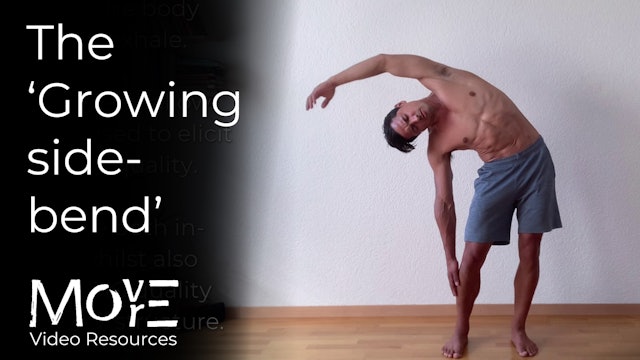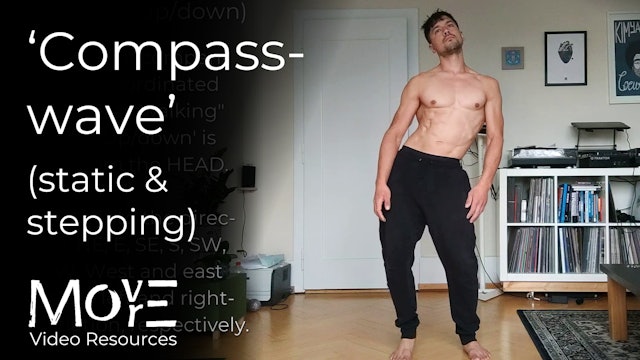-
Spinal 'pumping', breathing, & craniosacral exploration
THE WHAT:
As simple & highly accessible, stand-alone context for mobilising both the local (cervicothoracic & lumbar) as well as global spine. The addition of craniosacral exploration also brings a further context of sensitivity & manipulation to be explored/practiced. As it incorporates active s... -
IN FOCUS: 'Teacups'
THE WHAT:
Taking an 'In Focus' look at an ancient & fundamental arm-pattern, the 'Teacups'. This movement can be incorporated indefinitely into daily practice, serving as a 'constant' against which to as how you are feeling and moving at this point in time. A as rhythmical, breathing form, it can... -
The 'Growing side-bend'
THE WHAT
The 'Growing side-bend' or "breathe & grow" is a specific breathing form which expresses the length of the body's lateral-lines. Effectively a LOADED stretch utilising the weight of the head and overhead arm, it affects not only the spine in the frontal-plane but also the rib-cage, hips,... -
In Focus - Spinal Waves
THE WHAT:
Taking an 'In Focus' look at the nuances of the sagittal & frontal spinal-waves (up/down & down/up) with focus on working toward 'rhythmicality' as a key perspective of practice for ongoing patterning, as well as physiological, developmentResource contents:
00:05 - On perspectives of...
-
‘Down/up’ sagittal spinal-wave
THE WHAT
A fundamental 'spinal-wave' performed in the sagittal-plane. The initiation of this pattern is from 'down' (i.e. of the legs in connection with the ground) and transmitted sequentially 'up' the spine to the head-top. From here, it endlessly feeds back into itself in a CYCLICAL pattern wi... -
‘Hinging’ down/up wave
THE WHAT
A novel variation of the ‘Down/up sagittal spinal-wave’ incorporating a progressive hip-hinge & deepening of the torso toward the horizontal plane. As an effect there is SIGNIFICANTLY greater loading along the posterior-spine felt as an unavoidable fatigue, lending an innate conditioning... -
‘Up/down’ sagittal spinal-wave
THE WHAT
A fundamental 'spinal-wave' performed in the sagittal-plane. The initiation of this pattern is from 'up' (i.e. leading with the HEAD) and transmitted sequentially 'down' the spine to the spine into the ground. From here, it endlessly feeds back into itself in a CYCLICAL pattern with no s... -
‘Up’ & ‘Down’ spinal-wave switching
THE WHAT
The foundational 'Down/up' and 'Up/down' sagittal spinal-waves are now brought together in an integrated context which expresses switching between the two directions. The transition initially offers a minor coordinative motor-task requiring pre-"planning" of the switch and allowing time ... -
‘Down/up’ frontal spinal-wave
THE WHAT
After development of the fundamental spinal-waves & their 2 directions in the sagittal-plane (trajectory forward & back), we now bring focus to the FRONTAL-plane (trajectory side-to-side). Whilst the quality-standards & focus points concerning sequential articulation & 'rhythmicality' st... -
‘Up/down’ frontal spinal-wave
THE WHAT
After development of the fundamental spinal-waves & their 2 directions in the sagittal-plane (trajectory forward & back), we now bring focus to the FRONTAL-plane (trajectory side-to-side). Whilst the quality-standards & focus points concerning sequential articulation & 'rhythmicality' st... -
‘Up’ and ‘Down’ frontal-wave switching
THE WHAT
The foundational 'Down/up' and 'Up/down' frontal spinal-waves are now brought together in an integrated context which expresses switching between the two directions.Whilst any deficit in patterning & quality of the waves in their isolated directions will inevitably express in the integ...
-
Directional sagittal spinal-wave
THE WHAT
A stationary, global spinal-wave context which now explores the angular-potential of the ‘sagittal’ spinal-wave by turning the head AND torso and “waving” in those directions. Despite turning of the body, the trajectory of wave is still distinctly SAGITTAL – what is introduced is simply ... -
Integrating global spinal-waves
THE WHAT
A static exploration of global spinal-waves utilising the fundamental 'sagittal' & 'frontal' wave planes of motion in combination with the 'up/down' and 'down/up' directions. As a quality standard, always aim to express rhythmicality & sequential articulation of the spine in all patterns... -
Transverse spinal “flagging”
THE WHAT
A spinal-wave context oriented around the TRANSVERSE-plane, i.e. rotation left & right around an axis. It integrates pieces isolated in the practice of 'transverse spinal-segmentation'. Notably, it is performed on ONE leg, whilst also offering a 'toe-supported' variation when in the proc... -
The ‘Compass’ wave (static & stepping)
THE WHAT
The 'Compass-wave' offers a convenient structure within which to frame the practice of global spinal waves, expressing them both toward and from the eight inter-/cardinal coordinates (N, NE, E, SE, S, SW, W, NW) in both 'up/down' and 'down/up' directions.As with all global 'spinal-wave...

















